
MAY CONTAIN NUTS

Search Shorpy
SHORPY ART

Framed or unframed, desk size to sofa size, printed by us in Arizona and Alabama since 2007. Explore now.
Join and Share
Ad-Free Shorpy
Shorpy is funded by you. Patreon contributors get an ad-free experience.
Learn more.

Recent comments
- A Beautiful Moment
- Such joy
- Bethune-Cookman University today...
- Yellow sky at morning
- Side Winder
- Air Quality?
- Sojourner Truth riot
- None were so blind(ed)
- The less famous sister
- Good ol' days?
- Rise and Fall
- Goo Goo Ga Joob
- Ticket Retention
- Not the only one
- Vagaries of War
- Killed by Amtrak
- Back to the Future
- Wanted --
- If you can't stand the light
- Centralized Traffic Control, I believe
- What's really happening
- Heckuva remote control!
- Sometimes — Things Go Bump!
- I SEE THE LIGHT
- Union Switch and Signal Company
- Get That Light Out Of My Eyes
- Eggs. Eggs. Eggs. The Egg Man is Here!
- Foreboding caption
- Famous Hollywood faces
- Not just S&P
Member Photos
The Shorpy
Print Emporium
Print Emporium
Search Shorpy
Search results -- 30 results per page
- Whooooosh: 1902
- ... winning five-miles event in 6:1 3-5, Grosse Pointe track, Detroit." 8x10 inch glass negative, Detroit Photographic Co. View full size.
What the heck is "6:1 ... Posted by Dave - 08/25/2023 - 5:59pm -
![Whooooosh: 1902 October 24, 1902. "H.S. Harkness in his Mercedes-Simplex, winning five-miles event in 6:1 3-5, Grosse Pointe track, Detroit." 8x10 inch glass negative, Detroit Photographic Co. View full size.
What the heck is "6:1 3-5"?Is that some kind of time recording from yesteryear, or is it perhaps a biblical reference from even more yesteryears?
[361.6 seconds -- 6:01 and 3/5. - Dave]
Speedy!If I read that time correctly, Harkness averaged 48.19 MPH
49mphThat's right around an average of 49mph. 5 miles at 6 min 13.5 seconds.
Or is it 6 min 1 3/5 seconds? Either way, close to 49mph.
Almost Flying... and within a year and a couple of months, powered flight would be achieved.
Whenever I feel times are changing too quickly, I think back to if I were my current age a century-and-a-quarter ago. Getting past congratulating myself for making it to the ripe old age of 63, I would be utterly appalled by the spread of internal combustion engines, shattering the air with their noise and spewing smoke, scaring the horses, and breaking all the rules of the road!
Well, I'm pretty much still in that state of mind. So maybe not everything changes so quickly!
H.S. HarknessHarry Stephen Harkness, heir to a portion of the Standard Oil fortune, was a noted automobile racer and aviator. He cheated death in a 1910 airplane crash but was not able to buy his way out of the Spanish Flu epidemic. He died in 1919 at age 38.
ConsensusSome scientists of note back then warned of exceeding 60 miles per hour, postulating that a human would face a lack of oxygen and pass out at the controls.
They were wrong.
Not in Grosse Pointe AnymoreHorse racing was a very popular pastime in Detroit at the turn of the last century and two horse racing tracks were built on the south side of E. Jefferson Avenue. One was called the Detroit Driving Club, where this image was taken. It was located at Algonquin Street and was designed by Mortimer Smith. Farther east out Jefferson Avenue at Marlborough Street was the Jockey Club. Both were in the Fairview Village area of Grosse Pointe Township. The Ford-Winton Race and the 1904 Thousand-Mile Packard Endurance Run took place at the Detroit Driving Club.
It wasn’t until 1907 that this entire area was annexed by the City of Detroit and the names Fairview and Grosse Pointe Township became lost over the passage of time.
More here: https://wikimapia.org/33799129/Detroit-Driving-Club
(The Gallery, Cars, Trucks, Buses, Detroit Photos, DPC, Sports)](https://www.shorpy.com/files/images/SHORPY-4a09791a.thumbnail.jpg)
- Detroit Deli: 1912
- Detroit, Michigan, circa 1912. " Edelweiss Cafe , delicatessen room." 8x10 inch dry plate glass negative, Detroit Publishing Company. View full size.
Buy one new today ... motor. Amazing piece of engineering.
(The Gallery, Detroit Photos, DPC, Stores & Markets) ... Posted by Dave - 07/04/2011 - 2:14pm -
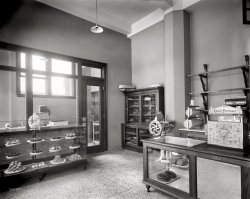
- Bizarro Detroit: 1904
- ... Fast-forward one year: The Detroit hard at work .
Ecorse, Michigan, 1904. "Great Lake Engineering Works. Steamer Detroit , Michigan Central Transfer, stern quarter." Or would that be ... Posted by Dave - 05/04/2017 - 9:14am -
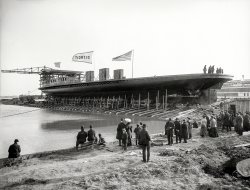
- Detroit Publishing: 1910
- Detroit, Michigan, circa 1910. "Detroit Publishing Company, east front." The mothership for much of the ... photography seen here. 8x10 inch dry plate glass negative, Detroit Publishing Company. View full size.
Home Sweet Home How nice ... Posted by Dave - 08/21/2012 - 12:38pm -
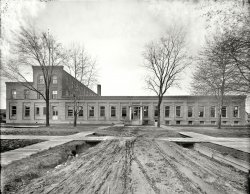
- Nashua: 1908
- ... and Fletcher's Optical Parlors. 8x10 inch glass negative, Detroit Publishing Company. View full size.
1908 and 2017
... Posted by Dave - 10/20/2023 - 3:43pm -
![Nashua: 1908 1908. "Main Street -- Nashua, New Hampshire." At right, offices of the Nashua Telegraph and Fletcher's Optical Parlors. 8x10 inch glass negative, Detroit Publishing Company. View full size.
1908 and 2017
PigeonsJust try to tell me pigeons aren't trash birds!
Safe spaceMaybe you heard this already but WalletHub just named Nashua, New Hampshire, the safest city in America. The other nine in the top ten are Columbia, Maryland; South Burlington, Vermont; Gilbert, Arizona; Warwick, Rhode Island; Portland, Maine; Casper, Wyoming; Yonkers, New York; Burlington, Vermont; and Scottsdale, Arizona.
According to the same study, South Burlington, Vermont (the third safest city), "also tied with Cleveland and Cincinnati, Salem, Oregon, Washington, D.C. and Seattle for the most hate crimes per capita." Uh oh. Maybe move to Burlington, Vermont -- less than three miles away and coming in at ninth on the safest city list.
Or just stay put and take your chances.
CLOUDS!I don't know if it was luck or some type of different exposure process, but it's rare to see a sky with clouds in these old photos. The cameras couldn't pick up the subtle shades and usually the skies appear completely white even though at the time they may have been overcast or partly cloudy.
Because now you can bank onlineWorking left-to-right:
JennyPennifer's comment caused me to pay special attention to the police officer walking his beat, just to the left of the wagon parked at the curb. He's dressed like a London Bobby.
The four-story building with the curved front is, regrettably, gone. This likely happened when Main Street was straightened, and a newer bridge was built across the Nashua River. The Romanesque church at the end of the street is on the other side of the river.
The building at right, which became a bank in jrpollo's update, is now luxury condos, called The Mint. Not to criticize too much, but my first efficiency apartment had more kitchen space. I guess the residents are expected to eat out. A number of nearby restaurants have expanded their al fresco option to include both the sidewalk and the parallel parking spaces in front of their restaurant.
Straight and trueI lived in Nashua for 12 wonderful years and lived in the North End right off of Concord. This image did raise a question about the curved building a block from the river crossing. Any straightening alluded to earlier would have taken place much earlier in the 19th century...
The Sanborn Insurance maps of 1912 indicate that Main Street and the bridge were already where they are today. But the curved building, identified as the Howard Block gracefully curved to widen the main street from the width of the bridge (I am guessing). Main Street really is three lanes wide in each direction... feels like an avenue in Manhattan. I am also grateful that the Library of Congress has these Sanborn maps...! Terrific detail about buildings and their particular use.
Here is the link to that image: https://www.loc.gov/resource/g3744nm.g3744nm_g053631912/?sp=32&r=0.517,0...
Different process = CLOUDS!Eary photographic processes were primarily sensitive to only blue light. Numerous newer processes throughout the late 19th century added increases sensitivity into the greens and yellows resulting in what we now call orthochromatic materials.
It wasn't until around 1906 that a truly panchromatic emulsion with full sensitivity to red was developed. This took several decades to become dominant. It wasn't until the panchromatic films and plates became available that we begin to see photos that can render skies anything other than nearly blank white.
Orthochromatic materials remained in use for quite a while largely because you could develop them under a red safelight. Panchromatic materials required total darkness.
[Here and here, some clouds from 1864! - Dave]
Light grey/white clouds against a blue sky require a panchromatic emulsion, otherwise the clouds and sky reproduce nearly the same light grey. Only when the clouds are all grey and dark grey (think: storm clouds) will they reproduce on earlier orthchromatic or pure blue sensitive emulsions.
Tea TimeThe Grand Union Tea Company delivery wagon in the Nashua photo made me curious. My local New Hampshire grocery store used to be a Grand Union. I found a brief history of the company here:
https://oldmainartifacts.wordpress.com/2013/10/07/grand-union-tea-compan...
(The Gallery, DPC, Small Towns, Stores & Markets)](https://www.shorpy.com/files/images/SHORPY-4a22639a.thumbnail.jpg)
- The Curb Market: 1905
- ... and curb brokers." 8x10 inch dry plate glass negative, Detroit Publishing Company. View full size.
No bars How did they ... Posted by Dave - 08/08/2012 - 2:03pm -
![The Curb Market: 1905 New York circa 1905. "Broad Street exchange and curb brokers." 8x10 inch dry plate glass negative, Detroit Publishing Company. View full size.
No barsHow did they ever get any business done? All of these businessmen, and not one using his cell phone!
What did she forget to tell him?Love the lady leaning out of the third floor window on the lower right to say something to the man who appears next to the lamppost, looking back up at her.
Hey JoeYou can meet my brother tomorrow afternoon on Broad Street. He'll be the one wearing the bowler.
No AutosIt's interesting that there don't appear to be any motorized vehicles in the picture. So far as I can see, everything is horse-drawn.
It appears to me that nearly all of the businessmen in the picture are wearing bowlers. For the most part, other hats, such as caps, are on younger men. Thus, I am guessing that the woman leaning out the window has sent the young man as a runner on some errand, and perhaps is, as coriander suggestions, adding something to the request.
The American Stock ExchangeThe "curbstone market" was the predecessor of the American Stock Exchange.
PeekingI love to see if anyone is looking out those windows ... Found one!
Lux MortemAwesome example of a Bishop's Crook Type #1 with crossbar. Today's reproductions are based on the BC type 24a, which look pretty close. But those globe luminaires hanging from the fluted fixtures are long, long gone.
What are we all looking at?It seems like there is a LOT of folks in the middle of the street doing something -- but what?
[Trading stocks. - Dave]
Au courantHere's the 1905 look, complete with a bowler hat..
And this is:Where I have all my money invested? Wish I would have seen this photo before my chat with an investment dealer.
Get that man a hat!I see you there to the left of the foreground globe... You think you can just stroll about in public half naked?
There's always one in the crowd!
One Hatless MaleAnd two women. Love the pic.
Neither Rain nor SnowGreat Photo! Does anyone know what the denizens of the Curb did when the weather got nasty, similar to what New York experienced this January?
Post Lux MortemThe crossbar is an artifact from the gaslight days, where the lamplighter would rest his ladder.
StandoutThere's one top hat (left foreground) vs 1,000 bowlers. Is this an executive? Mr. Peanut?
Nothing much changed by 1980I worked at 48 Wall Street for 16 years. Wall Street intersects at those steps at the top of the picture. That is where George Washington once spoke. Really, very little had changed. Most of those buildings were still there, and the crowd levels were the same. By 1975 crowds weren't playing stocks but 3 card monte that would scram when the lookout whistled.
Until about 1980 men with bowlers and tophats still walked the streets. They were carrying physical stocks and bonds between dealers. There was a 4 pm drop dead delivery for all transactions.
Hats off to youI'm reminded of the Simpsons episode where Homer ends up in the psych ward after wearing a pink shirt to the plant. The guys in lab coats were probably headed right for the poor hatless gentleman right behind the lamp bulb when this picture was taken.
Strange that a century later those wearing hats on a regular basis are the odd ones.
What are the vendors selling??I see apples and, what exactly? Parsnips? Carrots?
Topless on BroadPerhaps the crowd gathered are actually trading. Or maybe, when the man without a hat showed up, they all ran ran away from him, as if he were some strange alien, and are all discussing what they are going to do about this social deviant. Notice he's all alone there in the middle. Perhaps the man walking toward him (with something in his left arm...maybe a summons) will be the one to set him straight. "Sir, you need to put a hat on, or else. Get with the system, man."
A tale of two citizensA few paces behind the gent in the top hat is a fellow in working garb -- a lighter colored jacket that is open, with a different style hat.
And on the other side of the street, there is a fellow who is sitting on the railing, getting his shoes shined.
Three left standingActually only three of the buildings shown here are still standing: 1) The New York Stock Exchange of George B. Post (the pedimented building midway up the left side of the street), built in 1903; 2) the Subtreasury, aka Federal Hall National Memorial, originally the US Custom House (the partially visible Greek temple at the corner of Wall Street), built by Town and Davis, 1833-1842; and 3) the Broad Exchange Building, second from the right, built by Clinton & Russell in 1900. Everything else you see has been torn down and replaced by newer buildings.
[The poster below was speaking of the 1970s. - Dave]
You could hear a pin dropI worked on the Staten Island Ferry on weekends in the early 70's. The whole area was a ghost town when business was not in session. I remember the sound of a windblown rope hitting a flagpole that you could hear from blocks away.
The Third LevelSo few women, it looks like the Egyptian demonstrations. Only 100 and a few years ago, some of our grandparents just kids then, but the cityscape is overwhelmingly male (except for a few women selling fruits and vegetables from the carts). Are the men actually purchasing vegetables to bring home for supper? There's one man in the foreground on the left smoking a cigarette, while the man next to him has his hand up to his face like he is using a cellphone. Or making a gesture of some kind ("Hey, can you spare a smoke?") Of course, this could be a Jack Finney time traveler who forgot he isn't supposed to bring his cellphone and that not only do cellphones not work on planes, they don't work when you take the Third Level either.
Fruit CartsIf you're wondering what those carts are all about, they are selling fruit, not vegetables, to the brokers, who often didn't have time for a proper lunch. Instead, they'd grab a couple of apples or bananas, etc., and go back inside for more trading.
(This comment from food historian Jane Ziegelman)
ToucheI wonder what put a smile on the faces of the two men at bottom left, who btw look very much alike. Brothers? The bear of a man in centre front of the milling throng seems to be looking at the photographer.
SlapstickI got to thinking about all those discarded banana skins that seem to be in the gutters, on the road and doubtless on the footpath (sidewalk) in this photo. And wondered if this was a common sight in other locations where the fruit vendors plied their trade. Is this then the basis for the comical slipping on a banana skin routine? (BOBS).
A person slipping on a banana peel has been a staple of physical comedy for generations. A 1910 comedy recording features a popular character of the time, "Uncle Josh", claiming to describe his own such incident:
Now I don't think much of the man that throws a banana peelin' on the sidewalk, and I don't think much of the banana peel that throws a man on the sidewalk neither ... my foot hit the bananer peelin' and I went up in the air, and I come down ker-plunk, jist as I was pickin' myself up a little boy come runnin' across the street ... he says, "Oh mister, won't you please do that agin? My little brother didn't see you do it."(wikipedia)
Top 5This is truly a great picture but curious what makes it so popular that it has virtually become a permanent photo in the top 5? The last posted comment was on 2-19. Thanks for any info.
[Links from Stumbleupon and Reddit. - Dave]
Thought I would shareCute little moment they happened to catch.
Old Stomping GroundI love this 1905 photo and miss working at 25 Broad St (Paine Webber). I get a kick out of all the banana peels! Guess Peter Coyote is correct, it's a perfect food.
(The Gallery, DPC, NYC)](https://www.shorpy.com/files/images/4a12608a.thumbnail.jpg)
- Country Kitchen: 1942
- ... and the juicer. Ahhh, those were the days.
Made in Detroit -- "Tasty-Krisp Popkorn" ... just to the left of Sanka. ... Krisp Products was located at 11166 Grand River Avenue in Detroit. Now an empty lot in a much-decayed neighborhood, but in the 1940s it ... Posted by Dave - 01/19/2023 - 11:43am -
![Country Kitchen: 1942 July 1942. "Birmingham, Michigan (vicinity). Kitchen in a country house." 4x5 inch acetate negative by Arthur Siegel for the Farm Security Administration. View full size.
Eleven Years Later ... ... I finally see the rest of the kitchen. I clicked on "Kodachrome treatment" and discovered I made a comment on 01/01/2012.
[There's even a third pic! Check back in 2034. But seriously, the negative for this particular photo didn't get scanned until 2022. - Dave]
Drink Sanka Coffee and Sleep!My grandma use to drink Sanka. I remember seeing the jar in her kitchen when we'd visit. I also remember seeing Grandma's weed she kept in a big jar, between the Sanka and the juicer. Ahhh, those were the days.
Made in Detroit -- "Tasty-Krisp Popkorn"... just to the left of Sanka. Popcorn was the go-to snack in those days. Tasty Krisp Products was located at 11166 Grand River Avenue in Detroit. Now an empty lot in a much-decayed neighborhood, but in the 1940s it was growing and prospering.
Cold QuestionHave to wonder what the jar of cold cream is doing on the kitchen counter. With 6 sisters I sure saw a lot of that product in my youth, but always in the bathroom. Perhaps there's a culinary use I'm not aware of?
[In the kitchen, a cold cream jar is not necessarily a jar of cold cream. - Dave]
The MirolarmThe clock on the shelf is a Telechron Model 7F77, or "Mirolarm". Made between 1932 and 1938, it was Telechron's first "buzzer" alarm clock and would have been rose colored glass with a mirrored background.
[Not to be confused with "Mirro" brand kitchen timers, or Joan Miró. - Dave]
Grandma's weed?My first thought was: What’s a jar of nails doing on the kitchen counter?
From the breadbox libraryCharles Gundel's "Hungarian Cookery Book" had its first printing in 1934 and is still available 45 printings later, and Gundel's is a world-class restaurant in Budapest still in business today. If one enjoys Hungarian food, this cookbook with its delectable offerings is sure to throw one off their January weight loss diet.
Sone things never change (much)The bottle near the middle of the top shelf, in the paper wrapper, is clearly Angostura bitters. The labeling is amazingly similar to the one on my shelf, 80-plus years later.
And my tin of Colman's Mustard is still more like this one than it is different.
Bitters with the sweetThere's a bottle of Angostura bitters on that top shelf next to what might be maple syrup.
UtensilsArthur Siegel also gave this kitchen the Kodachrome treatment --
Maybe not weed --Oregano?
Well-wiredAny decorator magazine today would publish this kitchen with the word "whimsical" somewhere in there, but they would either studiously ignore the exposed electrical conduit, or comment on its "industrial" aesthetic. This is certainly an unusual abundance of electrical outlets for a kitchen of this period, and no doubt added at the owner's discretion to serve their abundance of kitchen gadgets. (How many people had an electric orange juicer in 1942?) Notice the light fixture above, with the original wiring concealed in the walls.
In 1940, the National Electrical Code added a requirement for a dedicated 20 amp circuit for kitchen appliances, something that had been recommended as a best practice for a couple of decades. My sense is that this rule was little-enforced, as wartime materials shortages soon prevented compliance. But here's the original concept, illustrated in an official publication of the 1893 World's Columbian Exposition.
Edit: I mistakenly typed "conduit," though this is clearly the first-generation iteration (1928-ca1950) of non-metallic sheathed cable, popularly known by the trade name Romex.
Brought to You By --Shorpy should get ad fees for product placement:
Kroger’s
Colman’s
Durkee’s
Jell-o
Sunkist
Sanka
Mary Scott Rowland
Grandma's laboratory Perfect meals
(The Gallery, Arthur Siegel, Kitchens etc.)](https://www.shorpy.com/files/images/SHORPY-8c28548a.thumbnail.jpg)
- Detroit Photographic: 1904
- New York circa 1904. "Detroit Photographic Co., 218 Fifth Avenue -- 26th Street front." Detroit Photographic, whose business was based on color postcard views and ... the turn of the century; in 1905 it changed its name to Detroit Publishing. In this view, the more you look the more people you see. ... Posted by Dave - 08/20/2012 - 1:31pm -
![Detroit Photographic: 1904 New York circa 1904. "Detroit Photographic Co., 218 Fifth Avenue -- 26th Street front." Detroit Photographic, whose business was based on color postcard views and framed prints, had stores across the country around the turn of the century; in 1905 it changed its name to Detroit Publishing. In this view, the more you look the more people you see. 8x10 glass negative, Detroit Publishing Co. View full size.
1, 2, 3I love the reflections in these windows. There are ropes and pulleys hanging out of the window of the building across the street, and the reflections of two people: one standing next to the photographer (reflected in Detroit's door) and another standing next to or leaning against the building across the street (reflected in the rug merchant's window). Together with Adolphe in the second-floor window, I count three people.
The sourceSo am I right in thinking that this country is still around and providing all the photos to Shorpy itself?
[The country is indeed still here. And just celebrated its 234th birthday. If you mean "the company," Detroit Publishing went into receivership in 1924 and was gone by 1932. - Dave]
Don't jump Adolphe!That bad, it couldn't be!
FinallyGood to get a glimpse of the source of so many unique and interesting photos!
No ingressThere must have been another entrance. The board across the two doors with the company name seems to effectively bar the door.
[What does it say on the board? - Dave]
Now, having worked retail, I'd have been ticked off with the 99% of customers who tried to open the door when it clearly says the entrance is around the corner.... and then been one of the 99%... Sigh....
SIDE Entrance!The caption states that this is the 26th Street side entrance to the store, and the photo shows specifically that the side entrance address is 5 West 26th Street. This is on the north side of the block, just off 5th Avenue, and just west of Madison Square.
Pre-Otis Those basement doors in the sidewalk can only lead to a stairway with possibly a wooden slider chute on one side. The later 'sidewalk elevators' didn't need the slope and were placed right up against the foundation. I loved to watch the deliverymen heaving crates and bales down those slides, it must have been rough downstairs, though.
(The Gallery, DPC, NYC, Stores & Markets)](https://www.shorpy.com/files/images/4a16766a.thumbnail.jpg)
- New Detroit: 1913
- Detroit, Michigan, circa 1913. "Dime, Penobscot, and Ford buildings." 8x10 inch dry plate glass negative, Detroit Publishing Company. View full size.
Sense of immensity ... ground level. At lunch during the 1984 World Series Champs Detroit Tiger parade, we watched the likes of Kirk Gibson, Lance Parrish, Alan ... Posted by Dave - 08/08/2012 - 2:31pm -
![New Detroit: 1913 Detroit, Michigan, circa 1913. "Dime, Penobscot, and Ford buildings." 8x10 inch dry plate glass negative, Detroit Publishing Company. View full size.
Sense of immensityThat's the feeling I have about this spectacular photo.
And vertigo, also.
Can even smell the smoke.
I like it very much.
Three PenobscotsIn the mid 1980s when I was in my early 20s, I worked on the 11th floor of the Ford Building. There was still a full-serve Sanders Cafeteria and store at ground level. At lunch during the 1984 World Series Champs Detroit Tiger parade, we watched the likes of Kirk Gibson, Lance Parrish, Alan Trammel, Lou Whitaker, Tommy Brookens, Jack Morris, and skipper Sparky Anderson travel east down Congress Avenue.
The three Penobscot Buildings always confounded me as well. The J.L. Hudson Department Store had closed by the time I worked downtown. I was always disappointed that I never visited that store as an adult.
A Little Early for the Penobscot? I just found out the iconic Penobscot building was not built until 1928. I can see the Dime building have identified the Ford building (at one time the tallest building in Detroit). I wonder if there was a prior building on site with that name--I doubt it after reading that the origin of the name is the Penobscot River (and Native American tribe) of Maine.
[There are, in 2011, three Penobscot Buildings on this block. At the time of this photo, there were only the first two. (If you look closely, you can see the word PENOBSCOT above the entrance on the taller one.) - Dave]
(The Gallery, Detroit Photos, DPC)](https://www.shorpy.com/files/images/4a25672a.thumbnail.jpg)
- Please-Freeze: 1917
- Detroit circa 1917. "Ice fountain, Washington Boulevard." The big icicle with a ... run all winter? Is this therefore a yearly spectacle?
Detroit Still Does It Detroit still has a giant ice pile each winter, but on Belle Isle now instead ... Posted by Dave - 10/13/2011 - 5:30am -
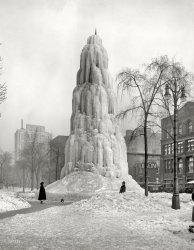
- The Pontch: 1910
- The Hotel Pontchartrain in Detroit, seen earlier today around 1907 in this post . Now it's circa ... many years later it was torn down to make way for a bank. Detroit Publishing glass negative. View full size.
Monumental Respect ... muffin top.
Goodbye Motor City It's too bad Detroit went to hell in a handbasket, and now the whole state of Michigan is ... Posted by Dave - 09/11/2011 - 9:42pm -
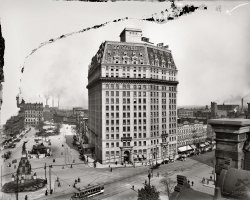
- Detroit Iron: 1903
- 1903. "Detroit Iron and Steel Co. mill." One of the wonders of the Rust Belt. 8x10 inch dry plate glass negative, Detroit Publishing Company. View full size.
Despite the pollution ... Zug Island The plant was located on Zug Island on the Detroit River, an artificial island formed when a canal was built for better ... Posted by Dave - 04/21/2015 - 12:11pm -
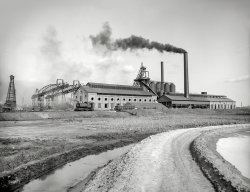
- Detroit tourism, 1930s
- Two passenger boats sit on the Detroit River near downtown Detroit, MI. They likely traveled across Lake Erie between Detroit and Buffalo, ... Posted by bhappel - 09/28/2009 - 11:09am -
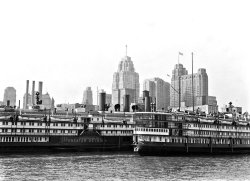
- Detroit Dental Depot: 1910
- Detroit circa 1910. "Library Park, Gratiot Avenue & Farmer Street." This ... has survived you most impressively.
(The Gallery, Detroit Photos, DPC, Stores & Markets, Streetcars) ... Posted by Dave - 03/28/2022 - 10:49am -
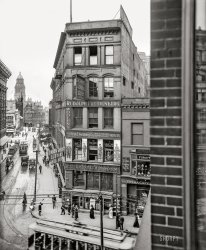
- Smoke Monster: 1905
- Circa 1905. "Transfer steamer Detroit of Detroit in the ice." 8x10 inch dry plate glass negative, Detroit Publishing Company. View full size.
Brand new tractors I ... Posted by Dave - 01/22/2013 - 11:21am -
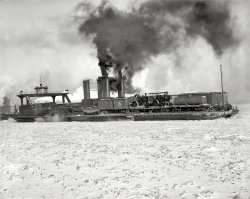
- Little Italy: 1900
- ... Street, New York." 8x10 inch dry plate glass negative, Detroit Publishing Company. View full size.
Where are the people? ... fotografia, magnificent photo, thank you.
Tinted Detroit Publishing also had a Photochrom (colored) version of this scene. Click ... Posted by Dave - 05/09/2020 - 6:49pm -
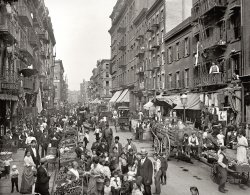
- Detroit Photographic Special
- ... Circa 1890s. "Delaware, Lackawanna and Western Railroad. Detroit Photographic Special." Detroit Photographic Co.'s rolling showroom-darkroom. View full size.
... Posted by Dave - 08/13/2012 - 7:26pm -
![Detroit Photographic Special Circa 1890s. "Delaware, Lackawanna and Western Railroad. Detroit Photographic Special." Detroit Photographic Co.'s rolling showroom-darkroom. View full size.
What is thatpointy spiked thing, located on the front of the engine next to the guy closest to the camera?
My Great Uncle's Old JobMy great uncle L.Glover worked for this railroad in the 1950's. His picture can be seen on their website.
Three numbers in three yearsThe Delaware, Lackawanna & Western had the peculiar practice of numbering locomotives for the division they worked; this all changed with new management in 1899.
Old 302 began its career as Buffalo Division no. 40 when constructed by Cooke in 1882. She weighed 81200' on her 57" diameter drivers, and was shop number 1238.
In 1899 the new Truesdale administration renumbered all the company's locomotives into a system-wide series. Hence, Buff.Div. 40 was renumbered 302. With new locomotives coming to the road, many engines were soon renumbered. Number 302 was renumbered DL&W 288 in 1902.
The Lackawanna had a very large number of these 2-6-0 Mogul types; they were used in freight service all over the system for many years. As trains got heavier and speeds increased, these old engines became obsolete all at once, whether they were thirty years or ten years old.Quite a few of these hogs were sold to other railroads or used equipment dealers all over the US and Cuba, but not our former 302; she was scrapped in 1903. [BTW, Dave, great shot. Keep the RR stuff coming...]
Sprayless LocomotiveI can't say I recall seeing fenders/splashguards on locomotive wheels before!
HmmThe sight of that leaky cylinder jacket suggests that we might be looking at some needed-but-deferred maintenance.
Hirsute Grandeur5 out of the 7 gentlemen sport very flamboyant mustaches. I wonder if the two up front on the cow catcher were part of the Detroit crew.
Front end factsThe vertical staffs on both ends of the pilot beam had two traditional uses. First, they acted as a handhold for employees to get from that tiny footboard on the bottom of the flimsy pilot to the pilot deck. Second, there was likely a slot in that staff to accommodate the flags that would be displayed during the daytime to indicate the class of the train.
Note the extended center sill bracketing the coupler. It made contact with the cars it would be shoving as a helper behind a train. These buffers were mostly added to locomotives and coal cars moving the anthracite that was the lifeblood of DL&W's business. These buffers were supposed to prevent jackknifing by the helper shoving too hard.
For you safety buffs, notice the short cut lever to operate the front coupler. Reaching in to "pull the pin" from that tiney footboard during inclement weather more than likely resulted in a report from the railroad that "employee died while irresponsibly moving between train."
The D, L, & WAh, the Delaware, Lackawanna,& Western. My father, who was a New Jersey commuter many years ago, said the letters stood for "delay, linger, and wait."
Cylinder cockThe wisp of steam near the cylinder jacket is coming from a slightly open cylinder cock.
Saturated steamThe 302 ran on saturated steam like the engines from this era. The high-pressure rectangular-shaped cylinders indicate that engine preceded the super-heated steam era.
(The Gallery, DPC, Railroads)](https://www.shorpy.com/files/images/SHORPY_4a20187a.thumbnail.jpg)
- Detroit Newsies: 1905
- Detroit circa 1905. "Journal building at Fort and Wayne." 8x10 inch dry plate glass negative, Detroit Publishing Company. View full size.
What a Blast This is the ... a boiler exploded in the Journal Building (home of the Detroit Journal newspaper and other businesses) in downtown Detroit, killing 37 ... Posted by Dave - 01/03/2017 - 4:26pm -
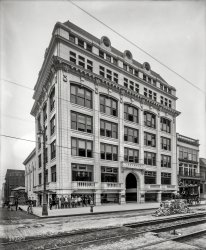
- Winter Crossing: 1900
- Circa 1900. "Detroit River. Car ferry Michigan Central entering slip." 8x10 inch dry plate glass negative, Detroit Publishing Company. View full size.
Who's with me? Winter break on the Detroit River!
Frigid Wonder This is just a beautiful photo, of an ... Posted by Dave - 08/02/2012 - 3:18pm -
![Winter Crossing: 1900 Circa 1900. "Detroit River. Car ferry Michigan Central entering slip." 8x10 inch dry plate glass negative, Detroit Publishing Company. View full size.
Who's with me?Winter break on the Detroit River!
Frigid WonderThis is just a beautiful photo, of an otherwise thoroughly utilitarian scene, just barely romanticized by having train cars and a paddlewheeler as subject matter.
The texture in the broken ice at foreground, the impressionistic smoke, and mist in the distance -- Wow.
Brr.I'm getting frostbite just looking at this picture.
All aboardI see the three sets of tracks, but would like to see the actual way they load and unload the box cars. I bet the guy smoking the pipe could have told us.
Extraordinary!This is an extraordinarily beautiful photo. The black and white textures are remarkable. I can feel the cold air and hear the ice crunching as the ferry drifts in. The ghostliness of the image is echoed in the misty distant skylines, and the whole is anchored by the two figures.
What a composition!
SkylineDoes anyone know if the ferry is pulling into Detroit or Windsor? Any clue from the church in the distance?
Interesting weatherCloudy, with a 100% chance of thumbprints!
Link & PinThe center car seems to be fitted with a link & pin coupling. The Railroad Safety Appliance Act took effect in 1900 outlawing these hand crushers on railroads engaged in interstate commerce.
Absolutely wonderful!As a person who lived in Archangelsk city, I used to see a scenes like this many many times. I feel the atmosphere, I even can feel a smell of it. Wonderful! Just great!
"Michigan Central"This seems to be the same sidewheeler design as in the previous shot of a car ferry, the "Transport." The names (hard to see) are stenciled on a signboard over the wheelhouse.
A ferry wonderland"The Great Lakes Car Ferries" by George Woodman Hilton has another photo of the Michigan Central on page 35.
Best. Photo. Ever.I've been reading Shorpy regularly since sometime in '07 when I saw a link on either Boing Boing or Neatorama. This is abso-freakin-lutely the Best. Photo. Ever. Bless you, and keep doing what you do.
Over the riverAt about this time, my grandmother may have been on a sleigh on the frozen river, on the way back to Windsor from Detroit, smuggling back cotton socks. She would have been 10 years old.
Such was the family story.
Great photoI am so impressed with the high contrast in the sky. If it were not clearly labeled as a scan directly from the negative, I would have assumed this was a print which had received a lot of attention in the darkroom.
This image is one of Shorpy's all time greats.
[All of the images on this site are adjusted for contrast in Photoshop. - Dave]
57 summers laterBelow is a scan of a 35 mm Kodachrome slide showing this same rail car ferry yard as it looked on July 6, 1957. The photo was taken from the deck of the Ambassador Bridge and its viewpoint is 180 degrees from that of the 1900 photo (the bridge was built during 1927-1929). View full size.
The church steeple seen in the distance on the 1900 photo is located in Windsor, Ontario. Here's a photo of it taken from the bridge deck just seconds prior to the one of the rail car ferry yard in Detroit.
Jules VerneyUntil you focus in on the rail cars, and the pictures resolves into the recognizable, there's a kind of Victorian Future-Shock quality to it.
Frozen in timeThe sharpness of the broken crystal shards could kill a man, they stand pointed end up, ready to cut a careless worker or walker, like razor-edged beveled glass. Two men are seen, yet each is lost in their own solitary thoughts. Possibly thinking "damn, it's cold."
Final departureIt looks like they are taking boxcars full of the damned over the river Styx.
The church might be in WindsorIt looks very much like Our Lady of the Assumption Church near the foot of Huron Church Rd. It is still there, presently in the shadow of the Ambassador Bridge.
If so, the view is downstream.
Detroit RiverThis is the Detroit side. The river flows extremely fast, and the ferry docks were set up so the boats always entered dock facing upstream. Michigan Central was built in 1884 by Detroit Dry Dock in Wyandotte, while Transport was built there in 1880. Both were cut down to barges by the 1930's. A nearly identical boat, Lansdowne of 1884, survived in steam until 1970 for CN/Grand Trunk, until she blew a cylinder head (I remember the shock among the Detroit trainwatching community at the time).
Her long survival was due to the limited size of the RR tunnels under the river, which couldn't handle hi-cubes and other large cars.
Lansdowne then became a floating restaurant, with two Milwaukee Road Skytop observation cars aboard. Recently scrapped in Buffalo.
I frequently went down to watch Lansdowne and an even older propeller ferry in the days of no security, "Sure, just be careful!"
WindsorI live in Amherstburg, about 20 miles downriver from Windsor. I love these photos of the Detroit River.
Great StuffI love these pictures of the Detroit River railroad ferries. My grandfather worked on these boats when he first came to Detroit from Pennsylvania in 1919. I remember watching them shuttle across the river during my childhood in the '60s and '70s.
Does anyone know what that factory on the right is? Is it the Michigan Peninsular Car Co. (aka American Car & Foundry)? It seems to be in basically the right place on the west side of Detroit. My great-grandfather, on the other side, worked there.
Building a ModelI'm building a 1/87 model of the train ferry Windsor, and these pictures and diagrams have proven to be invaluable.
Thanks, Terry Jolliffe
Belle River, Ontario
(The Gallery, Boats & Bridges, DPC, Railroads)](https://www.shorpy.com/files/images/4a04912a1.thumbnail.jpg)
- S.S. Deathtrap: 1910
- ... in the Chicago River. 8x10 inch dry plate glass negative, Detroit Publishing Company. View full size.
Media event The ... Posted by Dave - 09/24/2023 - 9:40pm -
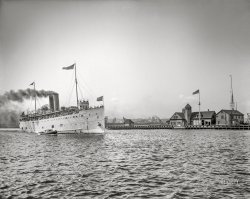
- Stuff It: 1922
- Detroit, Michigan, circa 1922. "Balch School students." Note the bin at left marked "STUFF ME with waste paper." Detroit Publishing glass negative. View full size.
Higginbotham Design ... Forum, 1922
Recent Developments in the Detroit School System
The necessity of making intensive use of all ... Posted by Dave - 08/21/2012 - 11:19am -
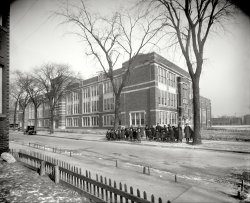
- Woodward at Witherell: 1907
- Detroit, Michigan, circa 1907. "Woodward Avenue at Witherell Street, looking south." 8x10 inch dry plate glass negative, Detroit Publishing Company. View full size.
Pony Car/Wagon ... If you're looking for a good piano, turn of the century Detroit is the place to go!
Ivories tower The Schwankovsky Temple of ... Posted by Dave - 08/28/2023 - 10:31am -
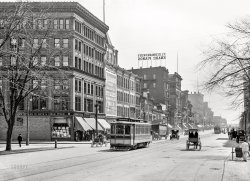
- The Club: 1916
- Circa 1916. "Detroit Athletic Club from the Plaza Hotel." Evidently something of a motorcar magnet. 8x10 glass negative, Detroit Publishing Co. View full size.
DAC magazine Contributors to ... why there were multiple hydrants so close together in the Detroit picture.
Five fire hydrants? Actually, Jimmy, I think there are ... Posted by Dave - 09/14/2014 - 12:25pm -
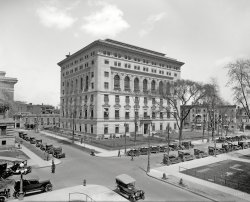
- Miami, Florida: 1908
- ... of this bustling metropolis? Extra points for Street View. Detroit Publishing Co. View full size.
UPDATE: The guesses as to ... tag that says "Florida," but there's also a tag that says "Detroit."
Follow up Follow up to my earlier comment about E.L. Brady; ... Posted by Dave - 10/14/2014 - 12:58pm -
![Miami, Florida: 1908 Circa 1908. Who would care to hazard a guess as to the location of this bustling metropolis? Extra points for Street View. Detroit Publishing Co. View full size.
UPDATE: The guesses as to the location of "Anytown, USA" (this post's original title) were, quite literally, all over the map -- from Deadwood to Buffalo to Whitehouse, Ohio. Many incorrect guesses for Titusville, Florida. The correct answer, and original caption: "12th Street, looking east, Miami, Florida."
Cigars, anyone?It looks like the main street of Ybor City near Tampa, Florida.
[Close, but no cigar. - Dave]
Titusville, FloridaMain Street
Titusville FloridaTitusville was the home of E.L. Brady Groceries!
GuessingI'm guessing it is Titusville.
Miami, 1200It would appear the MacArthur highway removed this locale:
View Larger Map
Location is.Titusville Florida
Titusville, FLTitusville. FL? A grocer with the same name had a building there:
I have to admit I'm not too confident; the bank building looks wrong.
Florida?Google search suggests that this may be early Miami, with E.L. Brady Groceries on right, and Frank T. Budge Hardware on the left.
Miami, FLI believe this is Miami, Florida, corner of 12th Street (now Flagler Street) and Avenue D (now Miami Avenue).
View Larger Map
I know, I know!It's the home of the Ace Novelty Company in Walla, Walla, Washington. What do I win?
Miami Map 1919This map shows Avenue D (now Miami Avenue) and 12th Street to be somewhere under the pilings for MacArthur Freeway. Too bad about the grand old house on the left a few blocks up. That shoulda been a keeper.
E.L. Brady's grocery storetells me this is Titusville, Florida.
Miami, FloridaThis is 12th Street, looking east, Miami, Florida.
Miami?A guy named E.L. Brady was a grocer in Miami around that time.
Wild GuessBrooklyn, New York
IdentityWashington Avenue, Titusville Florida.
Possible answerI cheated and Googled "E.L. Brady" grocery store" and got Titusville, FL. Did I win?
MiamiSome research indicates Flagler Street and Miami Avenue , although street view is hard to recognize.
MiamiAvenue D (now Miami Ave.) and 12th Street, Miami, Fl. It looks like it's beneath the MacAurther Causeway now.
Titusville FLA.Main Street?
Is it KC?It could be my eyes playing tricks, but I think I see a reference to Kansas City in the banner stretched across the street.
I'm guessingTitusville, Florida?
Taking a guessI think the location is somewhere in Titusville, Florida.
Titusville, Florida?Okay, here's my detective work. I Googled C.W. Schmid's Restaurant to no avail, but then I saw the E. L. Brady and Co. Groceries sign and tried that. It took me to this site, which mentions a store by the same name in Titusville. Am I right?
Brady Grocery, Titusville, Florida407 S. Washington Avenue, Titusville, Florida
"Titusville's first grocery store, L.A. Brady Grocery Store, was built in 1880. This and other buildings immediately south were occupied by Jackson Garage, Coca Cola, Bryan-Conway Realtors, Grower's Supply and Sears. The building was renovated and reopened in 1988 as the Granada Building, housing several government agencies and businesses including Gulf Atlantic Title, Cathedral Holdings and Loys Ward Surveying and Engineering."
I had not a clueBut I thought maybe somewhere up north because of the awnings, which I thought might protect from the harsh winter snow. Duh! I could not have been more wrong. Turns out they were protection from the hot sun of Florida! Having lived there for a tortuous 6 months, I should have known better.
I'm guessingTitusville,FL.
Jacksonville, Florida.It has to be Jax. There's crap in the street and it looks like a slum. Nothing has changed.
My guess is MiamiSearching for E.L. Brady's lead me to this conclusion based on this page, and this quote:
On March 3, Flagler dispatched John Sewell and twelve of his best black workers from Palm Beach to Miami to begin work on the townsite. They began by grading the site of Flagler’s hotel. (72) By late March the railroad extension had reached a point just below Arch Creek near today’s Northeast 135th Street. (73) Increasing numbers of people were coming to Miami. In order to provide them with a place to stay, Harrington and Tyler leased the Miami Hotel from Julia Tuttle — even before it had a roof over it. Located on today’s South Miami Avenue near the river, the hotel contained a dining room on the first floor and rooms on the second which only could be reached by ladder, since a staircase had not been completed. (74) A former steamboat, the Rockledge, was converted into a floating hotel by E. E. Vail, towed to Miami and docked at the foot of Avenue D (today’s Miami Avenue). (75)
Several new businesses had just opened or were about to open as March drew to a close. These included Frank Budge’s hardware store, Frank Duren’s meat market and green grocery, E.L. Brady’s grocery store, and the Lummus Brothers’ general store; additionally, a drug store, candy shop and pool room looked out over Avenue D. The lumber to build the Bank of Bay Biscayne building was being hauled to its lot next to the Brady grocery store. (76)
Survey saysI believe this is Brooklyn, NY. I took the easy way out and just searched for 1200 Avenue O from the side of the grocers wagon
Joe from LI, NY
View Larger Map
Miami?A Google search for
"e l brady" grocer 1200 ave d
turned up this link. On page 69 of which is mentioned a small grocery in Miami, run by an E.L. Brady.
A guessIs it Titusville Florida?
It's downtown MiamiThe Historical Museum of Southern Florida puts E.L. Brady Grocers, 1200 Avenue D, in Miami at that point. Avenue D is now South Miami Avenue. I'm not familiar with the area to know if the street numbering was retained.
Schmids Furniture, Whitehouse, OhioWhitehouse, Ohio? There is a reference to a "Schmids Funiture" still there in 1937 when this was written.
An updated guessIs it Miami, Florida?
MaybeTitusville, Florida?
TitusvilleStill working on the street view.
Miami, Florida?Miami, FL, 12th Street.
Anytown USA = Whitehouse OHIf you google "Schmid's Furniture" and have google uncorrect it, there's a PDF link to a report on Early Whitehouse History. In there is a reference to Schmid's Furniture on Toledo Ave (which looks very different today in Street View)
Some leadsA search for E.L. Brady's grocery brought up a couple things. This page mentions the cart part of the business, which would place this in Titusville, Florida, to the East of Orlando.
This link contains a picture of an historical marker in Titusville, which mentions that the building where Brady's grocery would have been housed in 1908 still stands, and is to the right of the sign. I'm pretty sure I've located the sign in street view here:
View Larger Map
The gardening has changed from the pictures, but the background matches up perfectly. The only step from here would be to go a few ticks over on street view and turn around, but this is where I stopped. Either I have the wrong spot or the view has changed considerably.
Found it?I found reference to E.L. Brady's grocery store which leads me to believe this is Titusville, Florida.
The building was home to E.L. Brady's grocery store. He first established his business in LaGrange, but moved to Titusville in 1886, occupying a wooden building at Main Street. The 1895 fire destroyed his store and many wood structures in the commercial district. Brady rebuilt his grocery in this building
Is this it?Not much left from 1908.
View Larger Map
No DoubtThat's downtown Anytown. (Read the heading.)
Titusville?Looks like E.L. Brady's Grocery store was located in Titusville, FL. That could be the site of this shot, perhaps...
Fort Pierce / St. Lucie, FLMan, is this a depressing indicator of change.
View Larger Map
ETA: Darn, not correct!
Miami, Fl ?http://www.hmsf.org/collections-south-florida-birth-city.htm
On March 3, Flagler dispatched John Sewell and twelve of his best black workers from Palm Beach to Miami to begin work on the townsite. They began by grading the site of Flagler’s hotel. (72) By late March the railroad extension had reached a point just below Arch Creek near today’s Northeast 135th Street. (73) Increasing numbers of people were coming to Miami. In order to provide them with a place to stay, Harrington and Tyler leased the Miami Hotel from Julia Tuttle — even before it had a roof over it. Located on today’s South Miami Avenue near the river, the hotel contained a dining room on the first floor and rooms on the second which only could be reached by ladder, since a staircase had not been completed. (74) A former steamboat, the Rockledge, was converted into a floating hotel by E. E. Vail, towed to Miami and docked at the foot of Avenue D (today’s Miami Avenue). (75)
Several new businesses had just opened or were about to open as March drew to a close. These included Frank Budge’s hardware store, Frank Duren’s meat market and green grocery, E. L. Brady’s grocery store, and the Lummus Brothers’ general store; additionally, a drug store, candy shop and pool room looked out over Avenue D. The lumber to build the Bank of Bay Biscayne building was being hauled to its lot next to the Brady grocery store. (76)
Anytown, USA is Titusville, FloridaAnytown, USA is Titusville, Florida
"E.L. Brady and Brother Grocery Store, a well established business located on Washington Ave. in downtown Titusville, put into use a delivery wagon in order to provide better customer service."
Judging by the number of wiresI would say: NYC.
Miami, Florida ...perhaps the corner of D (now Miami) and 12th Avenues?
After Titusville, FLAfter Titusville FL Mr. E.L. Brady, Grocer, moved to Miami and opened up his grocery store on Avenue D. Not sure what that is called now though.
Titusville Fla. Probably S. Washington St.
That was funThat was fun.
I was one of the Titusville people. Got it wrong. Oh well.
How about doing something like this once a week?
Not a palm tree in sightThe grocer E.L. Brady originated in Lagrange, Florida and relocated to Titusville, Florida in 1886. He would eventually became the first grocer in Miami, Florida at Ave. D and 12th Street. Today, this intersection would be Flagler Street and Miami Avenue. An interesting 1901 photo of the mustachioed Mr. Brady can be seen here.
A guessBuffalo, NY.
Found a reference to a wedding in the NY Times where Mr. and Mrs. E.L. Brady from Buffalo attended.
Brooklyn?Probably wrong, but I'll hazard a guess at Brooklyn; 1200 Avenue D is near the intersection of Flatbush, which would make that little side street on the left E. 23rd St.
View Larger Map
Is it Louisville?I think this may be Avenue D in Louisville, KY.
Miamihad an Avenue D in 1908 and a grocer called E.L. Brady.
Welcome to MiamiLooks like it's somewhere on what is now South Miami Avenue - possibly where the Route 970 overpass is now located?
FoundView Larger Map
Stop 17 on the historical walking tour.
Historical marker north of the building.
Hazarding a GuessI'm going to guess we're looking at Old Miam, South Miami Avei?
Just a GuessTitusville or Miami, FL.
Titusville, FLJust a guess.
Titusville, FLI think I see an atlas rocket taking off from the cape in the background.
Florida townI believe this is Titusville Florida.
LocationThis was taken in Miami, Florida at the corner of what is now Flagler Street and Miami Avenue. Everything in the original photo is gone, even the street names! Flagler and Miami used to be 12th Street and Avenue D, respectively.
Titusville, FloridaHome of E.L. Brady, Grocer.
Doesn't Look Like Florida to MeMy guess is Titusville FL, because that is the only place I can find a E L Brady that is a Grocer on the 1900 and 1910 census. Am I correct?
Miami, FloridaThat's my guess.
Deadwood, SD?Shot in the dark guess. Just seems very western.
Gag! I was wrong, wrong, wrong. Embarrassing since I was born and raised in Fort Lauderdale, and my grandparents + my mother moved to South Florida in 1917.
Miami, FL?Possibly Miami, as per an obituary for E.L. Brady (pulled from the "E.L. Brady and Co" store on the right, beyond the real estate agent).
That would make this shot somewhere in the vicinity of Flagler and Miami Avenue.
Miami FloridaAvenue D and 12th Street. Now Flagler Street and Miami Avenue. See if I can get a Street View.
Definitely MiamiFrom "Early Miami Through the Eyes of Youth" by William M. Straight, M.D., p.69:
"How did you get your dairy products and your groceries? Well, there were two grocery stores, little things. I think the first one was operated by a Mr. Brady, E. L. Brady, who moved here from Titusville."
On Page 63, there's mention that Avenue D is now Miami Avenue. 1200 Miami Avenue:
View Larger Map
MiamiE. L. Brady opened one of the first grocery stores in Miami, Florida. In 1908, the Bank of Bay Biscayne was located next door. I think this is the intersection of Miami Avenue and Flagler Street.
Let's see nowThere's a tag that says "Florida," but there's also a tag that says "Detroit."
Follow upFollow up to my earlier comment about E.L. Brady; according to the same obituary, E.L. Brady was an earlier settler of Titusville, FL, and started a grocery there, too.
So this could be Titusville, FL.
E. L. Brady Co. GrocersAt the corner of Avenue D and 12th Street in Miami:
Titusville, FLLooks like it's in Titusville, FL, though I'm having trouble pinning down the exact location for a Google Street View.
Halcyon HometownFinally, a shot of MY hometown, Miami!
When Miami scrapped its old street naming system in 1921, they threw out the house numbers along with the street names for the present day quadrant system.
The shot was taken on today's Flagler Street (formerly 12th Street) looking east at Miami Avenue (formerly Avenue D). The lions on the left guarded the Bank of Bay Biscayne, which stood on the northwest corner of Miami Avenue and West Flagler Street. The Halcyon Hotel, with its distinctive turrets, stood at East Flagler and 2nd Avenue (formerly 12th Street and Avenue B). It can be seen down the street on the left side.
It'd be great to see some more Old Miami shots! Thanks, Shorpy!
Let me guessI'm gonna go out on a limb here and guess that this city is in Florida?
I'm thinkingTitusville, FL
Thank you, Mr. Brady the grocerIt's Miami.
HOW COULD YOU TELL????I enlarged the photo, combed all the print details, how can you possibly recognize it a hundred years later????!!
(Thanks for the fun though.)
Bay Biscayne BankAccording to the Sanford Fire Map of 1899, the Bay Biscayne Bank was around the corner on D Avenue, on the NE side of the intersection, up the block on D Avenue slightly. Of course, it may have moved across the street to the NW corner by 1909. In the 1909 edition of Florida East Coast Homeseeker, it ran an ad noting it had moved to new digs in the Fort Dallas Bank Building; the one with the columns on the immediate left, and just west of the bank building, would have been the Biscayne Hotel in 1899. The weather bureau opened a station in the Bank of Bay Biscayne Building at that same location in 1911, so by then the building seems to have dropped the Fort Dallas appellation. The picture of the bank building provided by the NOAA website must be looking NW at it catercorner across the intersection.
(The Gallery, DPC, Florida, Miami)](https://www.shorpy.com/files/images/SHORPY-4a25100a.thumbnail.jpg)
- B. Altman: 1906
- ... Last seen here . 8x10 inch dry plate glass negative, Detroit Publishing Company. View full size.
Carriage 123, Where Are ... Posted by Dave - 10/10/2023 - 6:06pm -
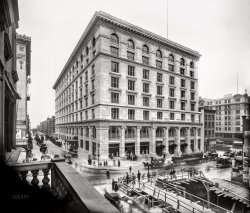
- Drs. K & K: 1910
- Detroit, 1910. "Michigan Avenue at Griswold Street and Lafayette Boulevard." ... a leather base.
Do yourself a favor If you get to Detroit, find this corner for some delicious Detroit Coney Island hotdogs . The brightly-painted triangular building is the ... Posted by Dave - 03/24/2023 - 1:19pm -
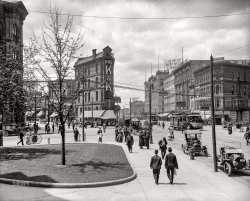
- Bon Voyage: 1903
- ... bound farewells." 8x10 inch dry plate glass negative, Detroit Photographic Company. View full size.
O Captain! My Captain! ... Posted by Dave - 10/08/2023 - 8:33pm -
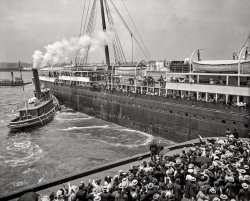
- Start Your Engines: 1903
- Detroit circa 1903. "Wayne County Building, looking east across Detroit River from Majestic Building." Opposite the Detroit Carriage Goods factory at right we find a sign advertising the business ... Posted by Dave - 09/08/2014 - 12:27pm -
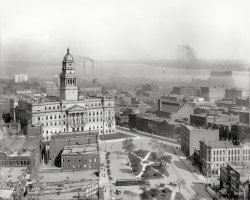
- East Grand: 1910
- Detroit, Michigan, circa 1910. "East Grand Boulevard." 8x10 inch dry plate glass negative, Detroit Publishing Company. View full size.
Expected to See More Cars ... Comparing the last couple of Shorpy pics of Detroit versus recent Google street view, I can't help but notice that there ... Posted by Dave - 04/26/2018 - 12:56pm -
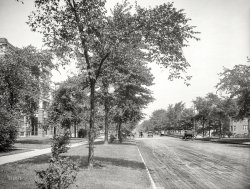
- Wayne County Building: 1908
- Detroit, Michigan, circa 1908. "Wayne County Building." The Motor City before it got very motorized. 8x10 inch glass negative, Detroit Publishing Company. View full size.
On the plus side, it's ... in the upper right - did they call them White Wings in Detroit as in NY?
Wayne County Cannon My curiosity was piqued by the ... Posted by Dave - 11/12/2022 - 3:52pm -
![Wayne County Building: 1908 Detroit, Michigan, circa 1908. "Wayne County Building." The Motor City before it got very motorized. 8x10 inch glass negative, Detroit Publishing Company. View full size.
On the plus side, it's still thereOn the minus side, they replaced the spire and got rid of the awesome statues on the roof. (Wonder what they did with those?) Amusingly, the cannon appears to now be a playground.
Creeping mechanizationI count 10 horse drawn vehicles and 11 motorized, so the tide is rising.
[Actually 11 horse-drawn. See lower right between the cars. - Dave]
Interesting that all of the steering wheels that can be seen are still right hand drive. Also another white clad street sweeper in the upper right - did they call them White Wings in Detroit as in NY?
Wayne County CannonMy curiosity was piqued by the cannon on the lawn. Was it connected with a significant battle, fort or warship (if it is a naval weapon)? Not there now, and the most recent photo showing it that I've found online is from the late 30s or early 40s. No other mentions that I've located, unlike the War of 1812 cannon formerly on the grounds of the old Detroit City Hall. Wonder if it was a victim of wartime scrap drives?
Ben-HurThose are incredibly large chariot sculptures on the roof.
Only 46 StarsThe flag flying over the courthouse in 1910 would only had 46 stars.
[And indeed they are 46-star flags. - Dave]
Something Else is MissingIn recent photos, not only is the cannon missing, but so are the rather large and detailed triumphal statues once mounted above the entrance pediment. I have yet to even see mention of that in any of my Detroit links. Many of the statues and the bell tower etc. from the old Detroit City Hall have been "stored" out in the elements for decades at Fort Wayne.
War prize from the cruiser Vizcaya"The prized cannon was taken from the Spanish ship Vizcaya during the battle of Santiago, Cuba, in 1898." (Detroit: A Postcard History.)
It was a 5½-inch (140mm) cannon. Apparently there is a 140mm cannon at Fort Wayne, so maybe that's where it was taken after it was removed from this site. Several of the ten 140mm guns went to places like West Point and Annapolis, according to this page.
[Everyone's grabbing cannons off the Vizcaya, or melting down bits of the ship to make cannon covers! I had no idea of the connection when I posted the very next photo. What an odd coincidence. Which we never would have found out about if tterrace hadn't asked his question. - Dave]
Hey buddy, you wanna buy a building?Unfortunately, the Old County Building, as it's called in Detroit, is now restored but empty. Wayne County moved its remaining offices to the nearby (and breathtakingly beautiful) Guardian Building a few years ago, and the place has been the subject of an ongoing legal dispute between the county and the developer to whom it was sold several years ago. In recent months a sign has been posted in front of the building that states "Historic building, for sale or lease."
The statuesThe sculptures were restored and and are back as of 2009.
Left and RightDuring the early years of the automobile in America, right-hand drive cars were popular for those who had chauffeurs.
Having the driver on the right enabled the chauffeur to quickly get out of the vehicle and open the back door where they passengers would be seated. It would have also enabled someone who was driving his own car to get out on the curb without stepping into muddy streets and also into traffic. In many places it was illegal for the driver to get out of a car from the traffic side, in some places, this law lasted well on into the 1960s.
Interestingly, the habit of exiting on the curb side even from cars with left hand drive, and even in situations where it is perfectly safe to do otherwise can be seen in a number of films. "Psycho" for instance. In almost every scene where a driver exits the car, the do so by sliding across the seat to the passenger side.
Quadriga RestoredThe two sculptural bronze charioteer groups of figures were removed for restoration, which took several years. They were hoisted back into place last December.
http://www.detroityes.com/mb/showthread.php?t=3763
The Statues are BackThe rooftop statues were returned a year or so ago - they had been removed for cleaning and repair. See them being installed (and close-ups) here.
(The Gallery, Detroit Photos, DPC)](https://www.shorpy.com/files/images/4a25765a.thumbnail.jpg)























